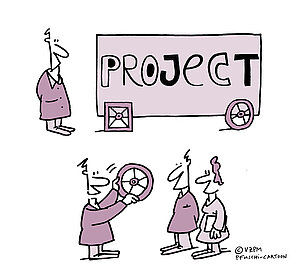Results orientation
Definition
Results orientation is the critical focus maintained by the individual on the outcomes of the project. The individual prioritises the means and resources to overcome problems, challenges and obstacles in order to obtain the optimum outcome for all the parties involved. The results are continuously placed at the forefront of the discussion and the team drives toward these outcomes. One critical aspect of results orientation is productivity, which is measured as a combination of effectiveness and efficiency. The individual needs to plan and deploy resources efficiently to realise the agreed results and be effective.
Purpose
The purpose of this competence element is to enable the individual to focus on the agreed outcomes and drive towards making the project a success.
Description
Most of the work in the life of projects deals with the definition and management of tasks and the resolution of smaller or bigger problems. In this definition, choices have to be made repeatedly, about priorities, allocation, to-be-used techniques, etc. Results orientation eases these choices by defining a basic criterion: Will the present work realise the desired results or make the process faster, cheaper and/or better?
Results orientation means focusing the attention of the individual and the team on key objectives to obtain the optimum outcome for all the parties involved. The individual has to ensure that the agreed outcomes satisfy the relevant stakeholders. This also applies to any changes agreed during the life of the project. While focusing his or her attention on the outcomes, the individual still needs to maintain an awareness of and react to any ethical, legal or environmental issues that affect the project. Results orientation also includes focusing the team and relevant stakeholders on delivering the requested outcomes, including identifying problems, using techniques to locate their causes and to find and implement solutions.
To deliver the outcomes required by and agreed with the relevant stakeholders, the individual must find out what the different participants in the project would like to get out of it for themselves. The individual must manage the deployment and development of the team members taking their expectations into account.
Key competence indicators
Evaluate all decisions and actions against their impact on project success and the objectives of the organisation
In everything the individual does, he or she is guided by the goal of the project, which is to achieve success. This goal underpins all the individual’s decisions and actions. Every choice may have negative or positive repercussions later on, so it needs to be carefully considered. The individual will judge new developments by the following criteria: Will this realise (or threaten) the objective or result, or make the process faster, cheaper and/or better and so more of a success?
Measures
- Considers the objectives and agreed outcomes of the project as leading all actions
- Formulates own goals based on the objectives and outcomes
- Derives the strategy of the project from the goals
- Judges all decisions and actions by their impact on the success of the project
Balance needs and means to optimise outcomes and success
Every choice entails allocating or denying means (resources, money, time, attention) to certain actions (tasks, decisions, questions, problems, etc) based on perceived needs. In order to optimise means allocation the individual must have a clear picture of the priorities of the project. Based on that, the individual must prioritise the various needs and balance the allocation of means based on the priorities. This may mean giving no attention or means at this stage to perceived challenges or problems, as the individual judges other needs to have greater priority.
Measures
- Assesses and prioritises various needs
- Explains why certain actions get more priority
- Uses the results orientation as a means to say ‘no’ (and explain why)
Create and maintain a healthy, safe and productive working environment
Ensuring a healthy, safe and productive working environment means providing the team with all of the required means and limiting distractions so that the team can focus on working efficiently. The individual acts as a filter and a buffer between the environment and the team members, absorbing uncertainties and ambiguities that could disturb progress and their results orientation. In addition, the individual facilitates the team with the necessary infrastructure and resources.
Measures
- Shields the team from outside interference
- Creates healthy, safe and stable working conditions
- Provides a clear set of work on which team members can operate
- Provides the necessary resources and infrastructure
Promote and ‘sell’ the project, its processes and outcomes
The individual often has to act as an ambassador and advocate for the project, explaining the why, how and what (its objectives, approach, processes and agreed outcomes) to all concerned parties. The promotion reinforces the results orientation by making clear the outcomes and the need for the outcomes. This can be done by regular reporting and stakeholder engagement, but at least as often is achieved by formal and informal communication and marketing, varying from coffee-corner talks with team members to formal presentations. This marketing or ‘selling’ the project is part and parcel of every communication made by the individual. The individual preferably also invites team members, the project owner and others to join in the marketing effort.
Measures
- Defends and promotes the objectives, approach, processes and agreed outcomes
- Seeks openings and venues to promote the project
- Invites others to join in with marketing the project
Deliver results and get acceptance
The litmus test of every individual is whether they can deliver, or realise what was promised, to get results. This quality requires a clear resource plan, planned outcomes, a strong belief in personal capacity and that of the team to overcome obstacles and problems, plus the overarching desire to deliver.
The individual knows that being effective is not the same as being efficient. Effectiveness is realising the planned goals (e.g. realising the agreed outcomes within agreed deadlines, budget, quality, etc), while efficiency is doing so with the least necessary cost and time (measured, for instance, by comparing the planned number of people against actuals). Therefore, the individual needs to constantly search for means to realise the agreed results faster, cheaper or better. Finally, the individual needs to be able to rally people to the cause while keeping to the planned level of productivity, knows what the individual can and cannot do (and get away with) in a specific situation and organisation and what is politically appropriate.
Measures
- Differentiates the concepts of efficiency, effectiveness and productivity
- Plans and sustains planned levels of efficiency, effectiveness and productivity
- Demonstrates the ability to get things done
- Focuses on and shows continuous improvement
- Thinks in solutions, not in problems
- Overcomes resistance
- Recognises limitations to getting results and addresses these shortcomings


